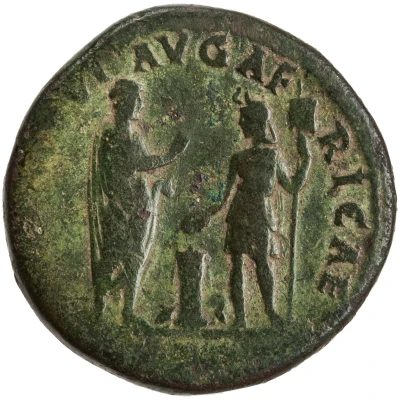


© American Numismatic Society (ANS)
Sestertius - Hadrian ADVENTVI AVG AFRICAE S C; Africa
| Orichalcum | 25 g | 32.5 mm |
| Issuer | Rome › Roman Empire (27 BC - 395 AD) |
|---|---|
| Emperor | Hadrian (Publius Aelius Hadrianus) (117-138) |
| Type | Standard circulation coin |
| Years | 130-133 |
| Value | 1 Sestertius = ¼ Denarius |
| Currency | Denarius, Reform of Augustus (27 BC – AD 215) |
| Composition | Orichalcum |
| Weight | 25 g |
| Diameter | 32.5 mm |
| Shape | Round (irregular) |
| Technique | Hammered |
| Orientation | Variable alignment ↺ |
| Demonetized | Yes |
| Updated | 2024-10-06 |
| Numista | N#256208 |
|---|---|
| Rarity index | 100% |
Reverse
Hadrian standing right, raising hand and holding scroll; facing him, Africa, wearing elephant scalp, standing left, holding patera and vexillum; between them, altar, with bull usually at the base.
Script: Latin
Lettering:
ADVENTVI AVG AFRICAE
S C
Unabridged legend: Adventui Augusti Africae. Senatus Consultum.
Translation: Adventus (Roman welcoming ceremony) of the emperor to Africa. Decree of the senate.
Comment
Source: Online Coins of the Roman Empire (OCRE)Interesting fact
The Sestertius coin , which features the Roman Emperor Hadrian and was minted between 130-133 AD, is notable for its depiction of Africa on the reverse side. The coin's design was meant to commemorate Hadrian's military campaigns in Africa, and it is one of the earliest Roman coins to feature the continent. The coin's reverse side shows a personification of Africa, depicted as a woman with a lion's head and a shield, surrounded by palm trees and other symbols of the continent's rich resources. This design was a departure from the traditional Roman coinage designs that typically featured gods, goddesses, and other mythological figures.